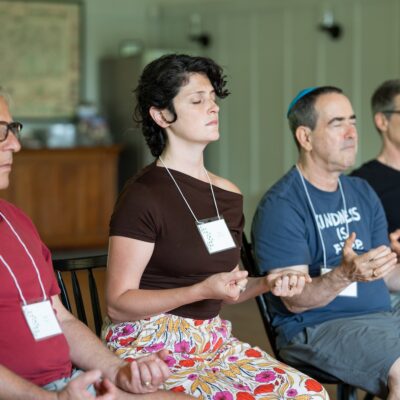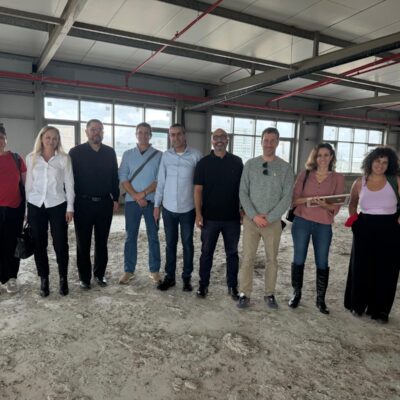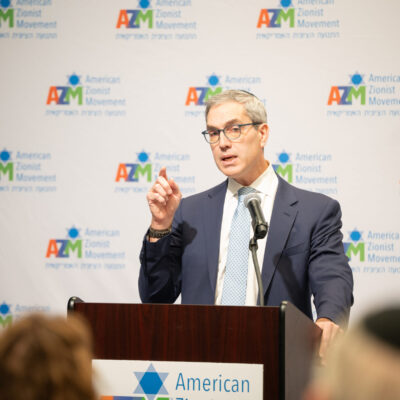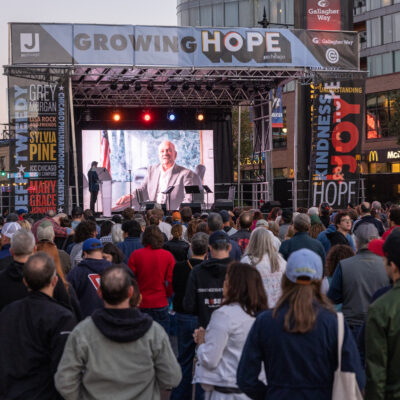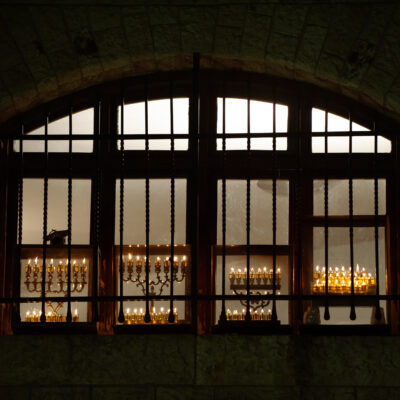Opinion
THE 501(C) SUITE
Getting the Jewish workforce out of ‘the Red Zone’

In eJewishPhilanthropy’s exclusive opinion column “The 501(C) Suite,” leading foundation executives share what they are working on and thinking about with the wider philanthropic field.
Recently, over morning coffee, my wife remarked to me how lucky I am to do the work I do to help the Jewish community in this moment.
She was and is 100% correct. “I know that I am so fortunate,” I said. “I have an amazing job, incredible colleagues and a brilliant and supportive board. I am on the funder side, where true emergencies are extremely rare.”
“Even with all that,” I confided, “I very occasionally wish I was doing something else. It’s hard to be in the Red Zone all day, every day, which has been the case since Oct. 7.”
“The Red Zone” is a reference to the work of Susan Britton, founder and president of The Academies. Her company focuses on training courses for leaders, businesses and organizations using evidence-based methods that are rooted in neuroscience. One of the cornerstones of her work is what she calls Blue and Red Zones.
These “zones” are measurable physiological states. When we feel safe, in Britton’s words, our “parasympathetic nervous system… brings heart rate and blood pressure to healthy levels, nurtures immune and digestive systems, and restores cortisol levels to baseline… [Thinking becomes] broader and more creative so that we can be more strategic and proactive.”
But when we feel threatened, she writes, “we get emotionally hijacked… [T]he sympathetic nervous system [spikes] us with extra cortisol, adrenaline, and other neurotransmitters. In this fight-flight state, the smartest part of the brain goes off-line (the neocortex), heart rate increases, vagal tone diminishes, and open-mindedness shuts down.”
As humans, we simply can’t spend too much time in the Red Zone. For sure, acute events happen — a loved one dies, a medical diagnosis scares us — but over time, people generally regulate back to “Blue Zones.” As Britton explains, “These temporary spikes are normal and functional when limited to a short period of true need, but damaging to organs over extended periods of time.”
In our incredibly volatile world, pressures on communal professionals have been steadily growing for over a decade. We thought that came to a head with COVID-19, but sadly, while that was very difficult, it was a picnic compared to what many professionals are experiencing today post-Oct. 7. That unprecedented day affected nearly all Jews — most intensely, of course, the direct victims and hostages, as well as their loved ones and all Israelis. For professionals in the Jewish communal world, the lingering impact of that day is felt 24/7 (yes, even on Shabbat) in other ways. In addition to the emotional toll, we feel it logistically as well, with new efforts aimed to support Israel, readjust organizational priorities and respond to rising intra-community and intercommunity tensions and a global upsurge in antisemitism. These efforts are a sprint and a marathon combined.
Recently I had the privilege to attend BBYO’s International Convention. I witnessed the power and joy of over 3,800 teens as they sang, learned, hugged old friends and simply hung out together. The convention was a space to grow personally, share their perspective on big issues and articulate their hopes and fears. I think in many ways I needed that time and experience more than they did. It was incredibly uplifting to be “in the room where it happens” and witness teens, well, just being teens in deep community.
All the uplift of that moment was in stark contrast with the general state of Jewish professional life right now. Over the past five months, I have spent time with dozens of colleagues representing the full range of positions and years of experience in the Jewish professional field. What I saw and heard in many conversations was, frankly, scary. The burnout is massive and the pressures on them are simply not sustainable.
Our people have been in the Red Zone for over five months; this is damaging to the Jewish community and the people who make it function. I fear this will cause a exodus of professionals in the field. Particularly as we inch closer to a surely heated and polarizing November election, the pressure and urgency are not sustainable. The “brain drain” will accentuate an already acute workforce and leadership pipeline problem.
To be sure, being in the Red Zone every once in a while can be a good thing to deepen one’s focus and accelerate progress toward a goal. But how can we get the Jewish workforce out of the Red Zone in the long term to counter an exodus before it occurs?
This will take a concerted and long-term effort, but here are a few basic ideas to get started:
1.) Make jobs doable by no longer fearing overhead. We need a serious rethink of the jobs we ask people to do. Our expectations of people should be, yes, demanding, but also manageable. That could mean leaders focusing more on key priorities and/or dialing back demand. To any leader, manager, board member or other stakeholder, I recommend that before you ask a professional for something, you ask yourself: Is this question important and/or urgent? If it is not, hold off.
On the flip side, making jobs more manageable could also be accomplished by hiring more people. Those who work in the Jewish community are our “raw material,” and yet we skimp and save like crazy. Even before Oct. 7, Leading Edge data from May 2023 showed that most employees and most CEOs at Jewish nonprofits don’t feel there are enough people in the organization to do the organization’s work. Since Oct. 7, that can only have gotten worse. More general operating support from more funders to our trusted grantees would begin to alleviate these feelings. Let’s not fear “overhead.” After all, Jewish professionals are in positions to bring joy to the community, but when their jobs are too overwhelming, that is impossible for them to do.
2.) Compensate our field better. If we want to attract and retain the best and brightest people, we have to pay them well. Why are so many entry- and mid-level employees, who are so critical to their organizations, paid so little while living in large cities (where many organizations are based) with high costs of living? This is even more egregious because we know how much day schools, camps, Israel trips and other programs cost in so many parts of the country. Ironically, working in the Jewish community can sometimes make it financially impossible to access the offerings in the community.
3.) Do more to activate boards to help. Boards will be vital in getting back to the Blue Zone. They are stewards of organizations’ resources and long-term strategies, as key partners to professional leaders, and as links between organizations and their communities. Boards need to support their professionals like never before in recognition of the massive amount of complexity they are dealing with every minute of each day. In the long term, we need to rethink the sacred and powerful alliance of how boards and professionals work together. It is often the “secret sauce” that makes our community tick, but a lot of the models are stale. When professionals get stuck in the Red Zone, their boards need to help stabilize and transition their work back to the Blue Zone.
One thing we can all do immediately is express gratitude
A little thank you goes a long way. Let’s go out of our way to acknowledge all that Jewish communal professionals are doing in this moment. We can show patience, kindness and the wisdom of our ancient teachings to judge others favorably.
Think for a moment how, for example, a Hillel professional’s job has grown exponentially. Instead of just focusing on joyful Jewish interactions, they now deal with student mental health, antisemitism, college administrators, safety and security — the list goes on and on. One job became ten. The same is true as the list of demands on many professionals grows and grows.
As I wrote a few months ago, these organizations are the heartbeat of Jewish life in North America. They need more resources, they need more champions, they need more colleagues—and they need a simple thanks.
So, to everyone in this field: thank you. You are giving it your all, you are tired and you’ve been in the Red Zone far too long. Your work and dedication are incredibly valuable.
We can all engage more thoughtfully and more gracefully with professionals. We can structure organizations to better attract young talent and support their success as they become veterans in the field. The Blue Zone is out there. We can get back to it. The vibrancy and health of Jewish professionals and communities depend on it.
Barry Finestone is president and CEO of the Jim Joseph Foundation.

 Add EJP on Google
Add EJP on Google
